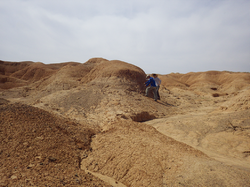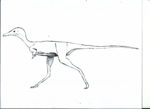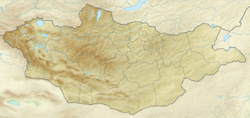Earth:Javkhlant Formation
From HandWiki
Short description: Geological formation in Mongolia
| Javkhlant Formation Stratigraphic range: Santonian-Campanian ~85 Ma | |
|---|---|
 Khugenetjavkhlant locality | |
| Type | Geological formation |
| Overlies | Bayan Shireh Formation |
| Thickness | 380 m (1,250 ft) |
| Lithology | |
| Primary | Mudstone |
| Other | Sandstone, conglomerate |
| Location | |
| Coordinates | [ ⚑ ] : 44°24′N 109°24′E / 44.4°N 109.4°E |
| Paleocoordinates | [ ⚑ ] 44°36′N 98°48′E / 44.6°N 98.8°E |
| Region | Dornogov |
| Country | |
| Type section | |
| Named by | Khand et al. |
| Year defined | 2000 |
The Javkhlant Formation is a geological formation in Mongolia whose strata date back to the Late Cretaceous possibly Santonian to Campanian. Ceratopsian, ornithopod and theropod remains been found in the formation. A prominent fossilized therizinosauroid nesting site is also known from the formation.
Paleobiota of the Javkhlant Formation
Dinosaurs
| Genus | Species | Location | Stratigraphic Position | Material | Notes | Images |
|---|---|---|---|---|---|---|
| Albinykus | A. baatar | Khugenetjavkhlant | "Partial hindlimbs and pelvic girdle."[1] | An alvarezsaurid. | 
| |
| Dendroolithidae indet. | Indeterminate | Khugenetjavkhlant | "Large nesting site composed by more than 10 egg clutches in several nests."[2][3] | A nesting area laid by a colony of therizinosauroids. | ||
| Enantiornithes indet. | Indeterminate | Khugenetjavkhlant | "Embryonic remains enclosed within an isolated egg."[4] | Bird eggs. Previously misidentified as neoceratopsian eggs.[5] | ||
| Haya | H. griva | Khugenetjavkhlant, Zos Canyon | "Skull with partial skeletons of multiple specimens."[6][7] | A thescelosaurid. | 
| |
| Ornithomimidae indet. | Indeterminate | Khugenetjavkhlant | Not specified.[8] | An ornithomimid. | ||
| Yamaceratops | Y. dorngobiensis | Khugenetjavkhlant, Shine Us Khuduk | Shine Us Khuduk red beds | "Skull with partial skeletons, including juveniles."[9][10] | A neoceratopsian. | 
|
| Zaraasuchus | Z. shepardi | Zos Canyon | "Skull and fragmentary skeleton."[11] | A gobisuchid. | ||
| Zosuchus | Z. davidsoni | Zos Canyon | "Skull."[12] | A shartegosuchoid. |
See also
- List of dinosaur-bearing rock formations
References
- ↑ Nesbitt, Sterling J.; Clarke, Julia A.; Turner, Alan H.; Norell, Mark A. (2011). "A small alvarezsaurid from the eastern Gobi Desert offers insight into evolutionary patterns in the Alvarezsauroidea". Journal of Vertebrate Paleontology 31 (1): 144–153. doi:10.1080/02724634.2011.540053. Bibcode: 2011JVPal..31..144N.
- ↑ Kobayashi, Y.; Lee, Y.; Barsbold, R.; Zelenitsky, D.; Tanaka, K. (2013). "First record of a dinosaur nesting colony from Mongolia reveals nesting behavior of therizinosauroids". 73rd Annual Meeting of Society of Vertebrate Paleontology. Los Angeles. pp. 155.
- ↑ Tanaka, K.; Kobayashi, Y.; Zelenitsky, D. K.; Therrien, F.; Lee, Y.-N.; Barsbold, R.; Kubota, K.; Lee, H.-J. et al. (2019). "Exceptional preservation of a Late Cretaceous dinosaur nesting site from Mongolia reveals colonial nesting behavior in a non-avian theropod". Geology 47 (9): 843−847. doi:10.1130/G46328.1. Bibcode: 2019Geo....47..843T. https://canvas.umn.edu/courses/125386/files/8393694.
- ↑ Varricchio D.J., Balanoff A.M., Norell M.A., 2015, "Reidentification of Avian Embryonic Remains from the Cretaceous of Mongolia", PLoS ONE 10(6): e0128458
- ↑ Balanoff, A. M.; Norell, M. A.; Grellet-Tinner, G.; Lewin, M. R. (2008). "Digital preparation of a probable neoceratopsian preserved within an egg, with comments on microstructural anatomy of ornithischian eggshells". Naturwissenschaften 95 (6): 493−500. doi:10.1007/s00114-008-0347-2. PMID 18347769. Bibcode: 2008NW.....95..493B. https://calacademy.org/sites/default/files/assets/docs/pdf/egg_kernberg.pdf.
- ↑ Makovicky, Peter J.; Brandon M. Kilbourne; Rudyard W. Sadleir; Mark A. Norell (2011). "A new basal ornithopod (Dinosauria, Ornithischia) from the Late Cretaceous of Mongolia". Journal of Vertebrate Paleontology 31 (3): 626–640. doi:10.1080/02724634.2011.557114. Bibcode: 2011JVPal..31..626M.
- ↑ Barta, Daniel E.; Norell, Mark A. (2021). "The Osteology of Haya griva (Dinosauria: Ornithischia) from the Late Cretaceous of Mongolia". Bulletin of the American Museum of Natural History 445 (1): 1–112. doi:10.1206/0003-0090.445.1.1. ISSN 0003-0090. https://bioone.org/journals/bulletin-of-the-american-museum-of-natural-history/volume-445/issue-1/0003-0090.445.1.1/The-Osteology-of-Haya-griva-Dinosauria--Ornithischia-from-the/10.1206/0003-0090.445.1.1.full.
- ↑ Khand, Y.; Bagamgarav, D.; Barsbold, R. (2000). "Cretaceous system in Mongolia and its depositional environments". Developments in Palaeontology and Stratigraphy 17: 49−79. doi:10.1016/S0920-5446(00)80024-2. ISBN 9780444502766.
- ↑ Eberth, D.A.; Kobayashi, Y.; Lee, Y.N.; Mateus, O.; Therrien, F.; Zelenitsky, D.K.; Norrell, M.A. (2009). "Assignment of Yamaceratops dorngobiensis and associated redbeds at Shine Us Khudag (eastern Gobi, Dorngobi Province, Mongolia) to the redescribed Javkhlant Formation (Upper Cretaceous)". Journal of Vertebrate Paleontology 29 (1): 295–302. doi:10.1080/02724634.2009.10010384. Bibcode: 2009JVPal..29..295E. https://www.researchgate.net/publication/259105787.
- ↑ Son, M.; Lee, Y.-M.; Zorigt, B.; Kobayashi, Y.; Park, J.-Y.; Lee, S.; Kim, S.-H.; Lee, K. Y. (2022). "A new juvenile Yamaceratops (Dinosauria, Ceratopsia) from the Javkhlant Formation (Upper Cretaceous) of Mongolia". PeerJ 10: e13176. doi:10.7717/peerj.13176. PMID 35402094.
- ↑ Pol, D.; Norell, M. A. (2004). "A New Gobiosuchid Crocodyliform Taxon from the Cretaceous of Mongolia". American Museum Novitates (3458): 1−31. https://digitallibrary.amnh.org/bitstream/handle/2246/2768//v2/dspace/ingest/pdfSource/nov/N3458.pdf?sequence=1&isAllowed=y.
- ↑ Pol, D.; Norell, M. A. (2004). "A New Crocodyliform from Zos Canyon, Mongolia". American Museum Novitates (3445): 1−36. https://digitallibrary.amnh.org/bitstream/handle/2246/2810//v2/dspace/ingest/pdfSource/nov/N3445.pdf?sequence=1&isAllowed=y.
 |


